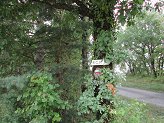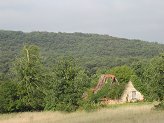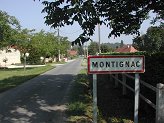| Click here or on any picture to switch to slideshow |
 | During our family camping holiday in Périgord I spent quite a bit of time exploring the countryside around the campsite. Only once however did I get onto a GR walk, the GR 461, one of a number of GRs in the area. Incidentally, these include the GR 6 which passes through Sarlat-la-Canéda and eventually gets into Bouches-du-Rhone not far from Marseille. I was planning to head north-east from la Chapelle-Aubareil where the campsite was and join the GR 461 halfway to Montignac. I could then follow the GR to Montignac and meet up with Carrie and the girls for a round of mini-golf. |
|
 | I had already explored the first part of the walk the previous evening, getting as far as Auxerre, an abandoned farmhouse about 2½km from the campsite. From there I continued along the route of a local marked walk through typical Périgord woods and fields. |
|
 | Near a small hamlet called les Combes I finally came onto the GR 461 and spotted the first red and white paintmark. This is a relatively short GR, starting at Terrasson-Lavilledieu on the Vézère, passing through St-Amand-de-Coly and winding its way west to join the GR 36 just west of Montignac. I was now at about the midpoint between St-Amand-de-Coly and Montignac. |
|
 | The main point of interest on this route was the Grotte de Lascaux, which contains one of the world's most famous set of prehistoric cave paintings. This might be worth stopping off to see if the public were actually allowed into the caves. Discovered by four teenagers in 1940, the caves stayed open to the public until 1963 when they were closed off due to damage from the heat and breath of visitors. Since then all you can visit is a replica of the main parts of the caves, which, according to some who've done it, is not terribly exciting. The real cave is now surrounded by an anonymous green fence and discreet "Keep Out" signs, which was interesting enough to see in itself. |
|
 | Once past Lascaux it was only a few minutes' walk before Montignac came into sight, with it's church and ruined castle clearly visible. |
|
 | Apart from having the caves of Lascaux just nextdoor, Montignac's other claim to fame is as the home of Eugène Le Roy, the nineteenth century writer. I had been reading Le Roy's most well-known work, "Jacquou le Croquant" to provide some cultural background to the holiday, set as it is amid the woods and hills around. Nineteenth century Périgord was a very poor region and the hero of the book, Jacquou, is a desperate outlaw who raises a rebellion against the wealthy remnants of the nobility, in an attempt to win back what had been lost since the Revolution. |
|
 | Nowadays happily there aren't too many signs of poverty in Montignac, a small but thriving town with a booming tourist industry during the summer. As I came into the town Carrie called me on the mobile phone I had with me to say that they were now in Montignac and would meet me at the mini-golf place. |
|
 | I had to get to the other side of Montignac to meet up with Carrie and the girls, which involved crossing the River Vézère by the old bridge. In fact it might have been quicker to go by the new bridge a little way up the river but the GR 461 took me to the old one - what can you do? |
|
 | Eventually I found my way through the town and out to the mini-golf centre, where we all met up for a game and a picnic lunch under the trees nearby. |
|

